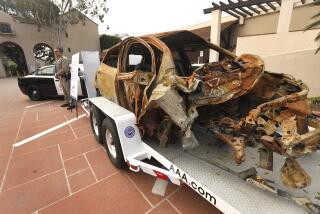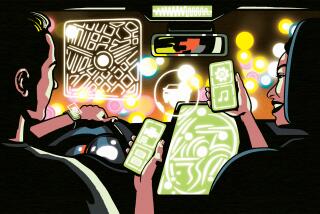When drivers’ brains get a busy signal
- Share via
We’ve heard the warnings. Whether that cell phone conversation is a simple reminder to pick up milk or the makings of a complex financial deal, when you’re behind the wheel, it detracts from the business at hand.
Now researchers are finding out exactly why. The brain can only do so much at once, they say, and as a result, can’t fully process the visual signals.
With the visual and auditory signals competing, the driver’s ability to see and react to what’s ahead -- even when gazing directly at a car, sign or pedestrian -- is diminished. This phenomenon of “inattention blindness,” in which the brain doesn’t fully process what the eyes are taking in, helps explain how cell phone conversations distract drivers and contribute to an increasing number of accidents. There are more than 137 million U.S. cellular subscribers, and studies show that the vast majority of them use their phones behind the wheel.
“Looking and seeing aren’t one and the same,” said University of Utah psychologist David Strayer, who has spent five years studying how cellular phone use interferes with driving. “Just because your eyes are directed at something doesn’t mean you’re processing it. Seeing means paying attention. When you’re not attending to driving, you’re more of a hazard.”
Strayer and his colleagues previously found that motorists talking on phones were more likely to react sluggishly to traffic signals or to simply miss them. With a conversation diverting their attention from the road, drivers are likelier to be tripped up by sudden events such as a child darting into their path, another car slamming on its brakes or a light change, Strayer said.
Many states have considered restricting cell phone use while driving. New York banned the use of hand-held phones by drivers in 2001, but Strayer and his colleagues have found that the impairment occurs equally with hand-held or hands-free models. That suggests the problem lies with the distraction of the conversation, not of holding the phone.
The research appears in the March issue of the American Psychological Assn.’s Journal of Experimental Psychology: Applied. Some of the findings also appear in the February/March issue of Injury Insights, published by the nonprofit National Safety Council.
The researchers drew their conclusions from several related experiments. They placed 20 college students in a high-tech driving simulator and had them pass numerous billboards while navigating a virtual road. Afterward, they tested the subjects’ recall of the billboards. They had 50% less recall of those billboards they passed while talking on the phone than those they passed while not using the phone.
In another experiment, they used video cameras and sophisticated instruments to track the students’ eye movements during virtual drives. Even when the instruments confirmed that the participants were looking directly at objects along the simulated road, those talking on the phone were less likely to remember the objects.
The authors noted that although half the participants believed it was tougher to talk and drive than just to drive, few thought their own driving was impaired by casual cell phone conversations, even when the experiment showed otherwise.
*
The numbers
* Number of cellular telephone subscribers in the U.S. (as of late January): 137,458,902.
* Estimated number of cell phone owners who use their phone while driving: 85%.
* Estimated cell phone use while behind the wheel: 60%.
* Estimated number of drivers using a cell phone during any daytime moment: 500,000.
* Increased likelihood of getting into an accident while driving and using a cell phone: 400%.
Compiled by Jane E. Allen






